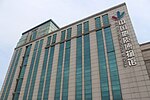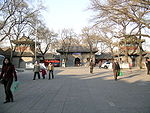Miaoying Temple
Gelug monasteries and templesMajor National Historical and Cultural Sites in BeijingPagodas in ChinaStupas in ChinaTibetan Buddhist temples in Beijing ... and 2 more
Xicheng DistrictYuan dynasty architecture

The Miaoying Temple (simplified Chinese: 妙应寺; traditional Chinese: 妙應寺; pinyin: Miàoyìng Sì), also known as the "White Stupa Temple" (Chinese: 白塔寺; pinyin: Báitǎ Sì), is a Chinese Buddhist temple on the north side of Fuchengmennei Street in the Xicheng District of Beijing. The temple was a monastery of the Gelug school of Tibetan Buddhism and is now open to the public as a museum. The temple's White Pagoda was built 1279 in the Yuan Dynasty and is the oldest and largest Tibetan Buddhist pagoda in China.
Excerpt from the Wikipedia article Miaoying Temple (License: CC BY-SA 3.0, Authors, Images).Miaoying Temple
阜成门内大街, Xicheng District Xinjiekou (首都功能核心区)
Geographical coordinates (GPS) Address External links Nearby Places Show on map
Geographical coordinates (GPS)
| Latitude | Longitude |
|---|---|
| N 39.924 ° | E 116.357 ° |
Address
妙应寺 (白塔寺)
阜成门内大街 171
100032 Xicheng District, Xinjiekou (首都功能核心区)
Beijing, China
Open on Google Maps











